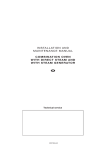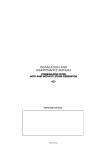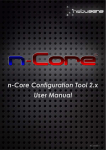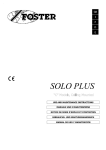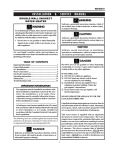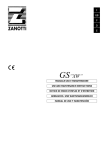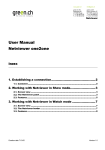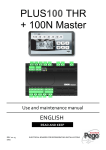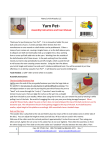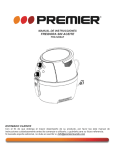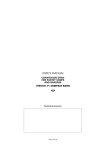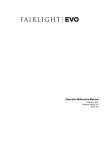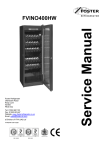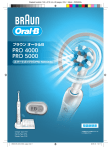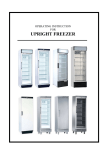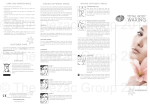Download installation and maintenance manual combination oven with direct
Transcript
I N S TA L L AT I O N A N D MAINTENANCE MANUAL C O M B I N AT I O N O V E N WITH DIRECT STEAM AND W I T H S T E A M G E N E R AT O R EN Technical service 90023620rev04 CONTENTS 1 • 2 • 3 • 4 • 5 • 6 • 7 • 8 • 9 • 10• 11• 12• 13• 14• GENERAL REMINDERS TECHNICAL DATA SPECIAL REQUIREMENTS FOR THE INSTALLATION SITE STATUTORY REQUIREMENTS, TECHNICAL REGULATIONS AND DIRECTIVES POSITIONING ELECTRICAL CONNECTIONS AND EQUIPOTENTIAL BONDING POINTS TO REMEMBER WHEN MAKING THE ELECTRICAL CONNECTION WATER AND DRAIN CONNECTIONS VENTS GAS CONNECTION PROCEDURES OPERATING AT THE RATED HEAT OUTPUT COMMISSIONING AND TESTING IMPORTANT information FOR the USER INSTALLATION DIAGRAMS Page 4 5 7 8 8 10 10 11 13 13 15 18 19 20 MODELS 4 x GN 2/3 5 x GN 1/1 6 x GN 1/1 7 x GN 1/1 7 x GN 2/1 10 x GN 1/1 10 x gn 2/1 20 x GN 1/1 20 x GN 2/1 VERSIONS M-Standard electromechanical devices with manual controls, humidifier and lighting. P - Programmable electronics with automatic humidity control, core probe and lighting. T - Scroller with automatic humidity control, twin speed, MULTIPOINT core probe, PLUS FUNCTION, lighting. (KL automatic washing system on request) S - Programmable electronics with direct access key to the programs and recipes, automatic humidity control and lighting. X - Touch-screen display, scroller with “push” function, programmable with automatic humidity control, twin speed, multipoint core probe, lighting and fitted shower unit. (KL automatic washing system on request) The manufacturer accepts no liability for any inaccuracies in this manual attributable to printing or copying errors. We reserve the right to modify our products as we deem fit, without impairing their basic features. The reproduction or copying of any part of this manual by any means whatsoever is strictly forbidden unless authorized previously in writing by the manufacturer. - ORIGINAL INSTRUCTIONS - 3 90023620rev04 1 •GENERAL REMINDERS 1.1 •The oven must be installed, commissioned and maintained only by an authorized service agent. 1.8 •Example of a data plate: LOGO 1.2 •Carefully read the directions given in this manual; they contain important information on safety during installation, operation and maintenance. Keep this manual in a safe place for future consultation! TYP. XXXXXXXX 2008 NR XXXXXXXXXX 3N AC 400V 50Hz 1 x 0.25 kW TOT 8 kW kPa 200 - 500 IPX 5 1.3 •This appliance must be put only to the use for which it is specifically intended, i.e. cooking foods; any other type of use is improper and therefore dangerous. LOGO 1.4 •Having removed the packing check that the appliance is not damaged in any way. If in doubt, proceed no further with installation of the appliance and contact the Customer Service or your dealer immediately. TYP. XXXXXXXX 2008 NR XXXXXXXXXX EN 203/A1 1 x 0.55 kW A3 G 25 1.5 •Packing materials are potentially dangerous and must not be left where children can play with them. / AC 230V 50Hz B13 m3/h Pmax / mbar Pmin / mbar IT 1.6 •Packing materials must be disposed of in conformity with local regulations. This normally means that the different materials are sorted according to type and collected as urban refuse. IPX 5 TOT G 20 1 / kW B23 m3/h Pmax / mbar Pmin / mbar Cat. II 2H3+ Qn 40 kW kPa 200 - 500 G 30 3.16 Kg/h Pmin / mbar P mbar 20; 28-30/37 0085 1.9 •The positions of the inlet and drain connections are clearly labelled. For further details, see the installation diagram attached to this manual. 1.7 •Before positioning and connecting the appliance, check that the utilities (electrical power, water and gas supplies) are as indicated on the data plate. The data plate is on the right-hand side, at the bottom. 1.10 •In the event of breakdown or faulty operation, switch off the oven immediately! 1.11 •During installation and/or maintenance work it is recommended you wear gloves to protect your hands. 1600 mm (63 inch) 1.12 •Safety sticker •Maximum height for inserting containers with liquids. ATTENTION: to avoid scalding, do not use the containers filled with liquid or food which, through cooking become fluid, at levels higher than those which can be observed. 4 90023620rev04 2 • TECHNICAL DATA Table 1: general data - ELECTRIC OVENS Model Supply voltage Frequency Total power input Amps Chamber power Boiler power Motor Oil-proof connecting cable (*) 4 x GN 2/3 3N AC 400 V 3 AC 230 V AC 230 V 50 Hz 3,25 kW 5 8 14 3,15 kW - 1 x 0,20 kW 5 x 1 mm2 4 x 1 mm2 3 x 1,5 mm2 5 x GN 1/1 3N AC 400 V 3 AC 230 V AC 230 V 50 Hz 6,25 kW 9 16 27 6 kW - 1 x 0,20 kW 5 x 1 mm2 4 x 1,5 mm2 3 x 4 mm2 2x 5 x GN 1/1 3N AC 400 V 3 AC 230 V 50 Hz 12,5 kW 18 31 6 + 6 kW - 2 x 0,20 kW 5 x 2,5 mm2 4 x 4 mm2 6 x GN 1/1 7 x GN 1/1 3N AC 400 V 3 AC 230 V AC 230 V 50 Hz 9,5 kW 14 24 41 9 kW 7,5 kW 1 x 0,25 kW 5 x 1,5 mm2 4 x 2,5 mm2 3 x 10 mm2 7 x GN 2/1 10 x GN 1/1 3N AC 400 V 3 AC 230 V 50 Hz 16 kW 23 40 15 kW 15 kW 1 x 0,55 kW 5 x 2,5 mm2 4 x 6 mm2 10 x GN 2/1 3N AC 400 V 3 AC 230 V 50 Hz 31 kW 45 78 30 kW 30 kW 1 x 0,55 kW 5 x 10 mm2 4 x 25 mm2 20 x GN 1/1 3N AC 400 V 3 AC 230 V 50 Hz 31,8 kW 46 80 30 kW 30 kW 2 x 0,55 kW 5 x 10 mm2 4 x 25 mm2 20 x GN 2/1 3N AC 400 V 3 AC 230 V 50 Hz 61,8 kW 89 155 60 kW 60 kW 2 x 0,55 kW 5 x 25 mm2 2x (4 x 25 mm2) (*) Flexible cable underneath sheath resistant to oil with designation 60245-IEC-57 Caution: The residual current device to be installed between the mains and the appliance must be sized for a leakage of 1 mA x kW of power installed. Table 2: general data GAS OVENS Model Supply voltage Frequency Input Motor Oil-proof connecting cable Gas power Gas power w/o boiler Gas connection 5 x GN 1/1 AC 230 V 50 Hz 0.25 kW 1 x 0,20 Kw 3 x 1 mm2 - 8,5 kW 1 x R 1/2" 6 x GN 1/1 AC 230 V 50 Hz 0,5 kW 1 x 0,25 Kw 3 x 1 mm2 14 kW 10 kW 1 x R 1/2" 10 x GN 1/1 AC 230 V 50 Hz 1 kW 1 x 0,55 Kw 3 x 1 mm2 28 kW 18 kW 1 x R 1/2" 10 x GN 2/1 AC 230 V 50 Hz 1 kW 1 x 0,55 Kw 3 x 1 mm2 40 kW 27 kW 1 x R 1/2" 20 x GN 1/1 AC 230 V 50 Hz 1,8 kW 2 x 0,55 Kw 3 x 1,5 mm2 48 kW 36 kW 1 x R 1/2" 20 x GN 2/1 AC 230 V 50 Hz 1,8 kW 2 x 0,55 Kw 3 x 1,5 mm2 80 kW 54 kW 1 x R 3/4" 5 90023620rev04 w/ boiler 2 • TECHNICAL DATA Table 3: GENERAL WATER DATA Model Water pressure kPa Softened water consumption max.l/h Water connection Model 6 x GN 1/1 7 x GN 1/1 200 - 500 10 2 x R 3/4" (1) 4 x GN 2/3 200 - 500 4 2 x R 3/4" (1) 7 x GN 2/1 10 x GN 1/1 19 2 x R 3/4" (1) 5 x GN 1/1 200 - 500 8 2 x R 3/4" (1) 200 - 500 200 - 500 30 2 x R 3/4" (1) 2x 5 x GN 1/1 200 - 500 8+8 2 x R 3/4" (1) 10 x GN 2/1 20 x GN 1/1 200 - 500 37 2 x R 3/4" (1) 6 x GN 1/1 200 - 500 8 2 x R 3/4" (1) 20 x GN 2/1 200 - 500 68 2 x R 3/4" (1) 15 2 x R 3/4" (1) 6 x GN 1/1 10 x GN 1/1 GAS WITHOUT STEAM GENERATOR 10 x GN 2/1 20 x GN 1/1 200 - 500 200 - 500 200 - 500 200 - 500 8 17 24 24 48 2 x R 3/4" (1) 2 x R 3/4" (1) 2 x R 3/4" (1) 2 x R 3/4" (1) 2 x R 3/4" (1) 7 x GN 1/1 GAS 20 x GN 2/1 200 - 500 ELECTRIC ELECTRIC WITH STEAM GENERATOR (1) Softened water Water pressure kPa consumption max.l/h Water connection 7 x GN 2/1 10 x GN 1/1 200 - 500 10 x GN 2/1 200 - 500 15 2 x R 3/4" (1) 20 x GN 1/1 200 - 500 30 2 x R 3/4" (1) 20 x GN 2/1 200 - 500 30 2 x R 3/4" (1) 5 x GN 1/1 200 - 500 8 2 x R 3/4" (1) 6 x GN 1/1 200 - 500 15 2 x R 3/4" (1) 10 x GN 1/1 200 - 500 22 2 x R 3/4" (1) 10 x GN 2/1 200 - 500 22 2 x R 3/4" (1) 20 x GN 1/1 200 - 500 30 2 x R 3/4" (1) 20 x GN 2/1 200 - 500 44 2 x R 3/4" (1) The ovens are equipped with two water inlets, one for non-softened cold water and the other for hot water (max. 50 °C) or softened cold water. Table 4: FLUE GAS EXTRACTION DATA (TYPE B13) Models Flue liner pressure Volumetric mass Flue gas temperature 6 x GN 1/1 7 x GN 1/1 10 x GN 1/1 10 x GN 2/1 20 x GN 1/1 20 x GN 2/1 - 0.9 Pa - 1.8 Pa - 2.7 Pa - 2.2 Pa - 18.6 g/sec . 28.4 g/sec. 34.5 g/sec. 39.9 g/sec. - 145 ˚C 190 ˚C 250 ˚C 210 ˚C - 6 90023620rev04 3 • SPECIAL REQUIREMENTS FOR THE INSTALLATION SITE 3.1 •The room where the oven is to be fitted has to be well ventilated with all the openings required for rooms with gas installations (see specific regulations). 3.6 •The room must have a water drain in a good position for the oven to be installed, its specifications are given under the heading “Water and drain connections” in this manual. 3.2 •In addition, it is good policy to locate the appliance under an extractor hood so that cooking vapours can be removed rapidly and continuously. 3.7 •The gas supply plumbing must be installed in accordance with current regulations, adopting pipe sections and pressures suitable for the appliance (see technical data and gas connections heading). A fast acting shutoff valve must be installed on the gas inlet line to the appliance. It is absolutely essential that this valve should be specified to current standards and type test approved. 3.3 •The room must have a flue gas extraction stack (appliances with installation type B13), or a suitable flue gas extraction system fitted with all relevant safety devices (appliances with installation type B23). Further details are given under the heading: “Gas connection procedures”. Check with the appropriate agency whether or not special authorization is required for the emission of flue gases into the atmosphere. 3.8 •The electrical isolating switch and the water and gas shutoff valves must all be located near to the appliance, within easy reach for the user. 3.4 •Current CEI (Italian Electrotechnical Committee) regulations require the installation of a multiple pole switch between the oven and the electrical power supply; the switch must have a contact gap of at least 3 mm on each pole. 3.5 •The oven needs two water supplies, one of which need not be softened, but must necessarily be cold (for condensing steam). The other supply, serving the vaporizer, must incorporate a softener with suitable flow and pressure specifications (see technical data and water connections heading). A shutoff valve must be installed on each of the water supply pipelines to the appliance. 7 90023620rev04 4 • STATUTORY REQUIREMENTS, TECHNICAL REGULATIONS AND DIRECTIVES Throughout installation it is vital to observe the following requirements: 4.1 •a n y h e a l t h a n d h y g i e n e s t a n d a r d s applicable to kitchens and eating places; 4.7 •the regulations of the electrical power supply company or agency; 4.2 •local and/or territorial building regulations and fire prevention standards; 4.8 •any other local regulations. 4.3 •current accident prevention guidelines; 4.4 •CEI requirements relating to electrical systems; 4.5 •UNI-CIG 8723 Standard “Gas systems for appliances used in professional kitchens and communal facilities”; 4.5 •the regulations of the gas supply company or agency; 5 • POSITIONING 5.1 •To position the appliances, it is recommended to use the mount offered by the manufacturer; should you want to do things differently, it is necessary to take account of the weight of the appliance. C u r r e n t f i r e r e g u l a t i o n s s h o u l d b e meticulously observed and respected. Do not obstruct the openings and slots in the casing as they disperse the heat in the electric component compartment. Keep strictly to the installation diagrams. 5.2 •Before manoeuvring the oven into the selected position, attach the water inlet hoses and waste pipe to the relative connection points (refer to headings describing the water and drain connections). 5.4 •Once the appliance is installed, the electrical power cable must be protected, and never stretched or tugged. 5.5 •The appliance must be level: any difference in level or sloping of the supporting surface should be eliminated. Differences in level or sloping negatively affect oven operation. 5.3 •The distances from other appliances or from adjacent walls that must be left to allow access for servicing operations will be found on the installation diagram for the oven to connect. In the event of the oven being installed directly against an inflammable wall, suitable heat insulation must be provided. 8 90023620rev04 5 • POSITIONING 5.6 •Remove all packing materials and peel away the protective plastic film from all external surfaces of the oven. 5.7 •For free-standing models, the appliance needs to be levelled: small differences in level of the supporting surface can be eliminated with the adjustable feet (by screwing or unscrewing them). A significantly uneven or sloping stance can affect the operation of the oven adversely. For models equipped with a pan trolley, it is necessary to pay special attention when levelling. OK OK 5.8 •Lining up the pan trolleys 20 x 1/1 GN and 20 x 2/1 GN. If the floor is not level, aremedy must be found using an access rampwith a maximum gradient of 4° (not included inthe supply). If there is an outlet grate in front of theappliance, it is necessary to fit runners in thepan trolley entry area. OK OK 201 - 202 X = 200 mm Y = 300 mm 9 90023620rev04 6 • ELECTRICAL CONNECTIONS AND EQUIPOTENTIAL BONDING 6.1 •As this oven is a type X appliance (oven without power cable and plug), the cable and other hardware needed to make the connection to the electrical power supply must be provided by the installer. The cable must satisfy the requirements indicated in table 1 “General data”. As already mentioned, the oven must be connected to the power supply by way of a multiple pole main isolating switch ensuring a gap between open contacts of at least 3 mm on each pole. 6.2 •To gain access to the AC mains connection terminal board, the right hand panel of the casing must be removed by undoing the fixing screws (all models). 6.4 •The oven must be kept in an equipotential system. This connection is made by wiring a conductor of nominal cross section 10 mm to the corresponding terminal at the back of the oven, which is marked with the internationally recognized symbol. All appliances in the room are bonded in this way and connected to the earth system of the building. 2 6.5 •The electrical safety of this appliance can be guaranteed only when it is connected correctly to an efficient earth system, in compliance with current standards. 6.3 •The cable must be fed in from beneath the clamp. The individual wires are then fastened to the corresponding terminals of the terminal board. The earth wire must be longer than the other wires, so that in the event of the cable being jerked or the clamp broken, the live wires will disconnect first. Check the efficiency of the isolating switch. 7 • POINTS TO REMEMBER WHEN MAKING THE ELECTRICAL CONNECTION 7.1 •As all ovens of the series are fitted with an alternating fan motor (clockwise and anticlockwise rotation), there is no need for the fan to rotate in any particular direction. Simply verify, when commissioning the appliance, that the fan is balanced and rotates freely. Warning: the 20 x GN 1/1 and 20 x GN 2/1 models are equipped with two motors. 7.2 •When making the electrical connection you need to take care that the neutral pin of the terminal block corresponds to the neutral wire of the supply line. If this connection is not made correctly, the burners will not be able to operate. 7.3 •This trouble is indicated: On gas models mechanical version by the burner ignition reset button, which is lit up. On gas models electronic version via the electronic card. 7.4 •Check also that the neutral registers zero potential when tested. If not, the fault already described in point three of this section will occur. In this eventuality, consult the installer of the building’s electrical system. 10 90023620rev04 8 • WATER AND DRAIN CONNECTIONS 8.1 • Water pressure The pressure of the water in the network must be between 200 and 500 kPa, as already stated under the heading “Technical Data”. If the supply pressure is higher than this, a pressure reduction valve must be installed between the oven and the main. 8.2 • Water connections to the BOILER (if applicable) and vaporizer The water supplied to the vaporizer must be either cold and softened or hot (max 50 °C), as described below. The water connection is R 3/4”. The hose for connection to the water supply must be provided by the installer. Do not re-use pre-existing or already used connection tubes. A shutoff valve must be installed on the line between the oven and the supply. 8.3 • Water specifications The characteristics of the water must come within the limits given below, in order to prevent both corrosion, which is extremely damaging for the appliance, due to supplying water that is too softened or too aggressive, and scaling in the oven and in the water system in the case of supplying water that is too hard. Hardness: between 3° and 6° TH PH: greater than 7.5 Chlorides: less than 30 ppm These values are important for ensuring that the water used by the appliance is suitably treated! 8.4 • Water connections for condensing steam The water used for condensing steam need not be softened, but must necessarily be cold. The water connection is R 3/4”. The hose for connection to the water supply must be provided by the installer. Do not re-use pre-existing or already used connection tubes. A shutoff valve must be installed on the line between the oven and the supply. 11 90023620rev04 8 • WATER AND DRAIN CONNECTIONS 8.5 • Draining The water is drained off by gravity through a heat-resistant pipe DN 50 (not flexible), maximum length 2 m, installed at an angle of no less than 4°. Mean temperature of the drain water: 65 °C. Fig. 1 For the range with the drain as per fig.1 it is possible to make a direct connection with an air trap, without fitting a drain cup, as the drainage manifold system has an internal air drop (Fig. 2). With a drain on the floor without an air trap it is necessary to have an outlet clearance of 2 cm (Fig. 3). Fig. 2 Fig. 3 min. 4 O 50 mm / 1,9 inch For the remaining models it is imperative to fit a drain cup to ensure a minimum air drop of 25 mm. between the appliance’s plastic drain elbow and drain line. A direct connection is not permissible. Min. 4 25 mm. Max. 200 cm WARNING: The drain line must be outside the perimeter of the oven. It is prohibited to reduce the drain diameter. 12 90023620rev04 9 • VENTS 9.1 • U nder no circumstances must vents A and B be shut, blocked or ducted into other pipes. A - Vent to extract vapours from the oven B - Safety vent A B 10 • GAS CONNECTION PROCEDURES 10.1 • GAS CONNECTION The section of the gas supply pipe must be chosen according to the type of gas and the consumption of the appliance to be connected. The system must be designed and installed in accordance with current regulations. T h e g a s c o n n e c t i o n o n the oven is R 1/2” or R 3/4”, and this section must never be reduced. A fast acting shutoff valve must be installed on the gas inlet line to the oven. The valve must be type test approved in accordance with current regulations. The connection to the gas main can be permanent or detachable; if flexible metal tube is used, this should be made of a stainless and corrosion resistant material (rubber hose is not recommended). If when making the connection you use any sealing materials, they must be type test approved for this purpose. 10.2•LEAK TEST All connections between the mains and the appliance must be tested for leakage. The recommended method is to use a proprietary leak detection spray; alternatively, a non-corrosive foamy liquid of any general description can simply be brushed onto the fittings: whichever method is used, no bubbles should appear. Never under any circumstances test for gas leaks with a naked flame! 10.3•EXHAUSTING FLUE GASES Model with 5, 6 and 7 pans GN 1/1 Since this appliance due to its capacity has installation type A3, it is not necessary to connect it to a stack for extracting the flue gases. The flue gases can be exhausted into the installation room. It is especially important to have good, continuous ventilation! Remaining models As these ovens have a power rating of >14 kW, type B installation is required. The installer must select one of the methods described below, according to the design of the building and of the room where the appliance is sited. The diameter of the flue pipes must be as indicated in the installation diagrams. Warning: flue gases may reach temperatures of 400 °C! Fumes must never be ducted away utilizing an extraction system! 13 90023620rev04 Clear the gas supply system of any machining debris before connecting the oven! 10 • GAS CONNECTION PROCEDURES Stack connection pipe Installation type B13 Extraction with natural draught fitted with a damper and a heat-resistant pipe (see “Flue gas temperatures” in Table 4 under the heading “Technical Data”) connected to the stack. Never under any circumstances must flue gases be ducted away directly utilizing a mechanical extraction system. Selecting this type of installation the oven must be fitted with a damper that is specific for each oven (as shown in the drawing). If the oven is equipped with an adaptor collar for standard size flue pipes, fit the adaptor. Adaptor Damper Suction hood Hood filter Ducted ceiling Note: It is the installer’s responsibility to ensure that the flue extension pipe has been correctly and securely fitted. Note: From the floor to the top limit of the flue gas extraction pipe (extension) there must be a minimum distance of 1.80 m. Where extraction systems are selected for type B13 and B23 installations, these must be properly sized and specified with at least one interlock device that will shut off the gas supply to the oven automatically in the event of the extractor system failing to operate. After installation, the installer must update the data plate by ticking the box, corresponding to the type of installation made, with an indelible marker pen. The manufacturer accepts no liability for any damage or malfunctioning of the appliance attributable to the absence or inadequacy of earthing systems, to the incorrect arrangement or installation of auxiliary systems, also to incorrectly made connections or to non-compliance of the building’s electrical system with current regulations. 14 90023620rev04 11 • OPERATING AT THE RATED HEAT OUTPUT 11.1 • A ll appliances, during final testing in the factory, are fitted for the type of gas shown on the sticker next to the data plate. Should the appliance fitting not correspond to the family of gases available on location, the appliance must be converted to adapt to the type of gas available. If conversion is necessary, then you must inform Customer Service and refer to the technical manual. 11.2 •Commissioning of the appliance to operate at the rated heat output is dependent on the inlet pressure and calorific value of the gas and the correct amount of primary air. 11.3 •The inlet pressure required for the appliance to operate with the various types of gas typically available will be within the limits indicated in table 6 of the “Tecnical gas data” booklet. The appliance must not be commissioned if inlet pressure values are outside these limits. If pressures differ from those indicated in Table 6, the gas supply company or agency should be contacted, or alternatively the contractor by which the system was installed in the building. 11.4 •The lower calorific value of the gas can be checked with the supply company or agency, and should comply with the information given in table 5 of the “Tecnical gas data” booklet. 11.5 • Measuring the inlet pressure The inlet pressure is measured using a manometer connected to the pressure tap (3) of the gas adjustment valve. To gain access to the valve, the right-hand side casing panel has to be removed. Before connecting the manometer it is necessary to loosen the screw sealing the pressure tap (3). You then measure the pressure with the burner in operation. The value shown on the manometer must come within the limits given in table 6 “of the “Tecnical gas data” booklet. After checking, carefully close the screw (3). The sealed screws you can see on the valves must never be tampered with under any circumstances. Tampering immediately invalidates warranty! Warning! The gas system components are fitted for a maximum pressure of 65 mbar. Higher working pressures are not permissible. 15 90023620rev04 11 • OPERATING AT THE RATED HEAT OUTPUT CHECKING NOMINAL HEAT CAPACITY M - P - T - S VERSION - Chamber Burner Check the depth of the screw “A” in accordance with table 5 of the “Tecnical gas data” booklet,using a gauge. Shift the J3 jumper in TEST position - see picture Check that the burner fan speed, corresponds to the data given in table 5 of the “Technical gas data” booklet. Set 180 °C convection cooking at low speed (where applicable), otherwise at normal speed. Check the speed at position “IGN”, with the J3 jumper in TEST position. After testing, shift the J3 jumper in the initial NORM position. Check the speed on position “MIN”. Set the normal speed and check the speed at position “MAX”. Check the combustion, CO (ppm) and CO2 (%) values, with an appropriate instrument: Start the oven working, 180 °C convection mode, open the door and activate the microdoor with a magnet fixed with tape, the oven restarts and wait for approximately 5 minutes. Position the flue gas collection probe in the flue gas outlet pipe (chamber and boiler). The CO2 must be for: Natural gas between 9% and 10.5% L.P.G. between 11% and 13% he CO must be no greater than 300 ppm T (measured). C arry out the test in both convection and steam mode. If these readings are outside the ranges, proceed as stated in the technical manual. For the conversion from natural gas to LPG, or vice versa, proceed as described in the technical manual. Reading in: D-E = Hz (0-200Hz) D-F = VDC (0-6 VDC) - Boiler Burner Repeat these operations, setting 100 °C steam cooking. J3 MAX MIN IGN A E F D 3 Conversion: As mentioned above, every appliance is factory set to burn the type of gas specified, it may become necessary nonetheless to convert the appliance from one type of gas to another. Therefore, only personnel authorized by the company and belonging to the technical service who have the corresponding technical handbook can do this work. 16 90023620rev04 11 • OPERATING AT THE RATED HEAT OUTPUT CHECKING NOMINAL HEAT CAPACITY X VERSION Check the combustion, CO (ppm) and CO2 (%) values, with an appropriate instrument. Start the oven working, with the door open, and wait for approximately 5 minutes. Position the flue gas collection probe in the flue gas outlet pipe (chamber and boiler). Check the depth of the screw “A” in accordance with table 5 of the “Tecnical gas data” booklet,using a gauge. The CO2 must be for: Natural gas between 9% and 10.5% L.P.G. between 11% and 13% Access the settings page for the burner to be checked: SERVICE PASSWORD BURNER SETTINGS he CO must be no greater than 300 ppm T (measured). I f these readings are outside the ranges, proceed as stated in the technical manual. For the conversion from natural gas to LPG, or vice versa, proceed as described in the technical manual. Check that the burner fan speed, corresponds to the data given in table 5 of the “Technical gas data” booklet. Set 180°C convection cooking, operating with “MIN” and “MAX” speeds and with the doors open. - Boiler Burner Repeat these operations, setting 130°C steam cooking (also with door closed). Chamber Burner 1 A 3 Conversion: As mentioned above, every appliance is factory set to burn the type of gas specified, it may become necessary nonetheless to convert the appliance from one type of gas to another. Therefore, only personnel authorized by the company and belonging to the technical service who have the corresponding technical handbook can do this work. 17 90023700rev01 12 •COMMISSIONING AND TESTING 12.1 •Check the appliance and the entire installation straight after connecting. Check in particular: •there are no traces of the protective film on the outside walls and the oven is empty; •all the vents are clear; •the connections are made as required and instructed in this handbook; •all the safety requirements of the current standards, laws and directives are met; •there is no leakage from the gas and water connections; •water drainage and flue gas extraction are clear. •Apply the adhesive with the warning signal against the scalding danger at a height from the ground of 1.6m. 1600 mm (63 inch) 12.2 •Now proceed to light the oven as directed in the user manual, checking the smooth ignition of the burner. 12.3 •You should moreover check that the silicone joints and sleeves of the water circuit (oven vent, oven outlet, drip tray) do not leak. 12.4 •Carefully refit the right-hand side that was removed for the above work. 12.5 •For additional certainty that the appliance is operating correctly, carry out a volumetric measurement of the quantity of gas consumed. The meter will show how much gas has been consumed over a given period of time, and this value can be checked against the values given in Table 5 of the “Tecnical gas data” booklet. 12.6 •The test report must be completed in full and submitted to the customer, who should then sign in acceptance. With effect from this moment, the appliance is covered by the manufacturer’s warranty. 18 90023620rev04 13 • IMPORTANT INFORMATION FOR THE USER 13.1 •With the user manual to hand, show the user the functions, safety devices, appropriate use and, above all, the time intervals for servicing the oven. Maintenance operations include cleaning the burners, inspecting the combustion chamber and cleaning the various ducts and pipes, and should be carried out at least once a year. With this in mind, customers are recommended to sign a service agreement. 13.2 •Ensure the user is fully aware that such repair and/or maintenance operations as may become necessary over time must be carried out only by an authorized service agent. 13.5 •Explain to the user that certain faults in operation are often due to simple errors or oversights such as failure to switch on or connect utilities. Accordingly, kitchen staff should be trained in such a way that they can use the appliance confidently and understand how it operates. Faults of a recurring or persistent nature must be investigated by an authorized Service Agent. 13.6 • E xplain clearly that any alterations to the room or changes in ventilation may affect the operation of gas-fired appliances. In these cases, it is advisable to have the oven functions checked over. 13.3 •Explain clearly to the user that in the event of breakdown or faulty operation, all connected utilities (water, electricity and gas) should be shut off immediately. 13.4 •Keep the installation manual and the wiring diagram for future reference. Explain to the user that the user manual supplied with the oven must be kept near the oven in a place where it can be seen. It is good policy to make a note, in the user manual, of the name and contact numbers of the selected Service Agent. 19 90023620rev04 INSTALLATION DIAGRAM 14 • INSTALLATION DIAGRAMS 25mm / 0,9inch 50mm / 1,9inch DISTANCES TO OBSERVE 500mm 20inch We recommend keeping a distance of 500mm/20inch on the right-hand side in order to carry out maintenance work. DO NOT INSTALL APPLIANCES WITH A SOURCE OF HEAT ON THE RIGHT-HAND SIDE OF THE OVEN CAUTION: if the ambient temperature to the right of the appliance is too high, the oven will stop for reasons of safety. Minimum distance from sources of heat on the right-hand side: 400mm/15,7mm. 400mm 15,7inch 20 90023620rev04 notes 21 90023620rev04 notes 22 90023620rev04
























